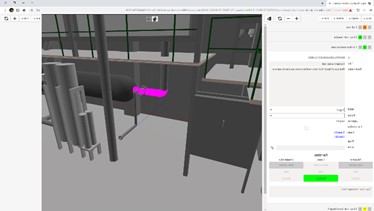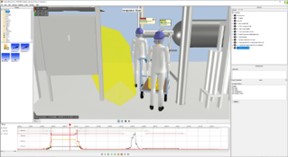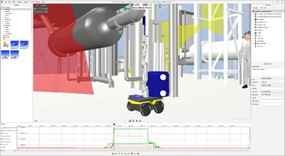
Two validation tests were carried on the Halden Research Reactor:
- Risks and uncertainties analysis in decommissioning and dismantling (D&D) operations, using remote and manual operations.
- Comparison of risk, dose exposure, time and cost for a radiological characterization of a pipe-bend inside the reactor hall by both remote and manual operation.
The purpose of the tests was to demonstrate how well the PLEIADES platform perform in comparing the two different D&D operations, but also how different tools involved in the D&D planning can exchange data using the BIM (Building Information Modeling) platform.
Risk analysis was performed with the RiskBIM tool. RiskBIM loads the 3D model from the BIM database and lets the user define risks at different levels and associate them with parts in the 3D model. The 3D model is in IFC-format and the risks identified are stored in the BIM database with reference to the IFC model.

Figure 1: Risk identification with the RiskBIM tool.
Planning the radiological characterization was done with the VRdose® tool. The VRdose® tool loaded data, like radiological measurements, equipment, workers and the 3D-model from the BIM database. The remote and manual characterization was then simulated in VRdose® and at the same time recording individual dose uptake for the workers and time used to complete the task. Other tools from several of the project partners were also used to visualize the 3D model and radiological data, estimate waste, estimate cost and performing sensitivity analysis, like DEMplus®, iDrop, BIMsync, RadPIM, AquilaCosting and Wastream.

Figure 2: Manual radiological characterization in VRdose®.

Figure 3: Remote radiological characterization in VRdose®. Radiological measurements are shown as red and yellow fields in the 3D model.
The dose uptake and time-data were saved to the BIM database after the simulation was done and used to make a comparison between the remote and manual operation. The important result here is that the PLEIADES platform proved to work very well for comparing various D&D scenarios, and not the result of the individual operations. The comparison between the manual and remote operation showed that the difference in terms of cost, time, risk, and dose exposure was small, but in favor of the remote operation. Exchange of data between different tools also worked well by using the PLEIADES database connector for data exchange between the tools and the BIM database.
Follow the project’s LinkedIn page and subscribe to our newsletter to keep up-to-date with the project’s progress!
